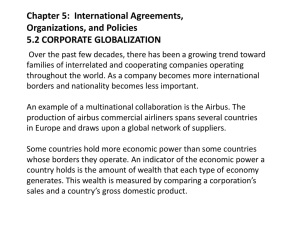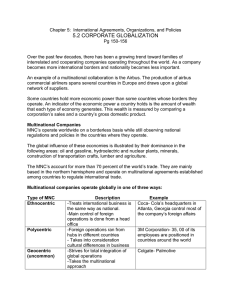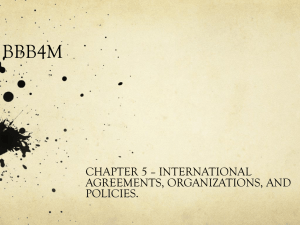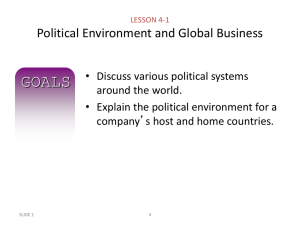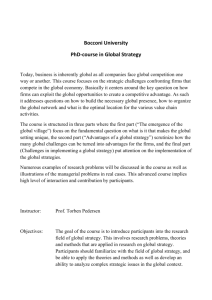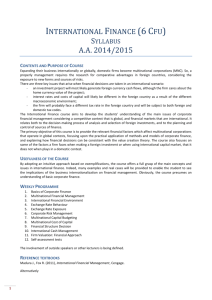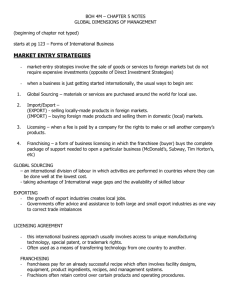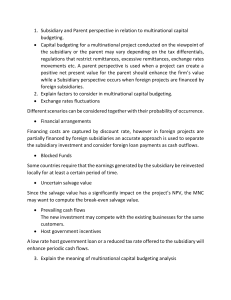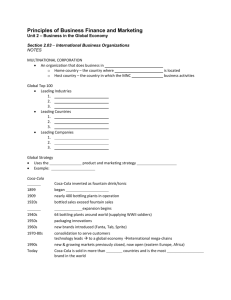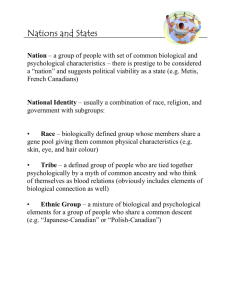Powerpoint Slides
advertisement
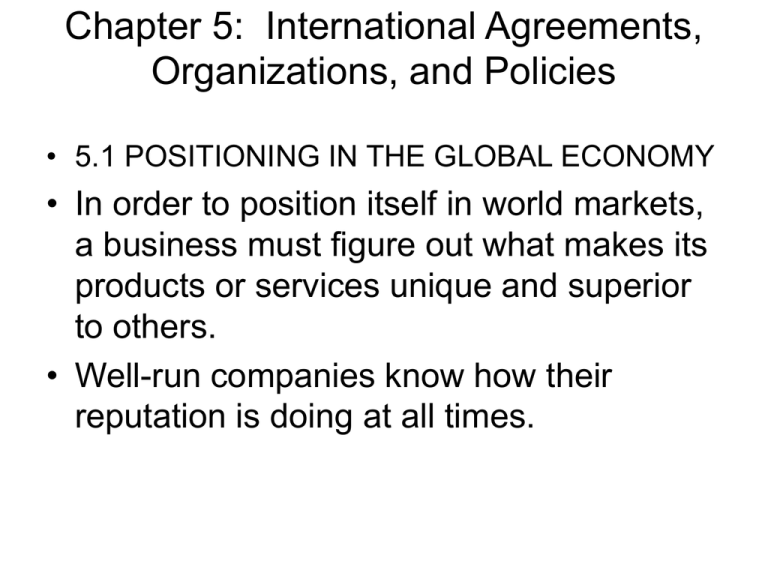
Chapter 5: International Agreements, Organizations, and Policies • 5.1 POSITIONING IN THE GLOBAL ECONOMY • In order to position itself in world markets, a business must figure out what makes its products or services unique and superior to others. • Well-run companies know how their reputation is doing at all times. Strategies toward Global Positioning 1. A form of exporting and importing done through a licensing agreement, where a company pays a fee to another company from a different country to produce or sell that company’s products. 2. Franchising a business: the franchisee pays a fee percentage in order to be able to ride on the success of the franchisor 3. Wholly owned subsidiary that operates in the host country - A subsidiary may bear, and operate under, a different name or be owned by a company’s larger subsidiary in similar area of business 4. The next popular international market entry strategy is to purchase in foreign markets the parts or materials required for manufacturing a product in the home market. • This method is mostly used in the automotive industry. 5. Joint Venture – combining parts, expertise, and complementary technologies from different countries to produce a product • Many Japanese and North American automobile firms frequently use this approach 6. Strategic Alliance • two or more firms cooperate to co-develop, co-produce, or co-market their products • Sometimes such partners also cross-invest; that is, they buy each others shares, usually to ensure supply or to share risk and profit. • The Japanese term for this is keiretsu; in South Korea, it is known as chaebol. In Western nations it has been referred to as “Japan Inc.” International and Global Companies • We live in an age characterized by interdependence among nations and economies. • Today’s trend toward the globalization of business influences everyone. • Individuals everywhere must be able to work with people of different cultures and be aware of international events. • Companies expand internationally to increase sales and profit, and for a variety of other reasons. • Some international companies think of their foreign operations as appendages, which usually produce and sell products designed and engineered in the domestic market and sometimes adapted for local needs, culture, and tastes. • A global company is one in which top management makes decisions to maximize worldwide revenues, income, and profits. Global companies encourage employees to move from country to country, and they promote foreign nationals to top management positions. Benefits and Challenges in Global Companies Advantages: Challenges: • Savings in raw materials and labor by moving production facilities to locations where wages are lower • Worldwide access to the most innovative ideas and designs • Ability to market a product to meet worldwide needs and wants • Job creation in developing nations • Cost of creating and maintaining a global presence • Political, economic, commercial, and foreign currency exchange risks 5.2 CORPORATE GLOBALIZATION • growing trend toward families of interrelated and cooperating companies operating throughout the world • An example of a multinational collaboration is the Airbus. The production of airbus commercial airliners spans several countries in Europe and draws upon a global network of suppliers. Multinational Companies • MNC’s operate worldwide on a borderless basis while still observing national regulations and policies in the countries where they operate. • The global influence of these economies is illustrated by their dominance in the following areas: oil and gasoline, hydroelectric and nuclear plants, minerals, construction of transportation crafts, lumber and agriculture. • The MNC’s account for more than 70 percent of the world’s trade. They are mainly based in the northern hemisphere and operate on multinational agreements established among countries to regulate international trade. Multinational companies operate globally in one of three ways: Type of MNC Description Example Ethnocentric Polycentric Geocentric (uncommon) -Treats international business is the same way as national. -Main control of foreign operations is done from a head office -Foreign operations ran from hubs in different countries - Takes into consideration cultural differences in business -Strives for total integration of global operations -Takes the multinational approach Coca- Cola’s headquarters in Atlanta, Georgia control most of the company’s foreign affairs 3M Corporation- 35, 00 of its employees are positioned in countries around the world Colgate- Palmolive Triad • The unity between the USA, EU, and Japan • These three economies joined together create a huge power in the business world • Because their economies are so strong, it is hard for other countries to compete against them • To stay relevant, other countries must create freer trade agreements and lower their standards to give them an advantage against the Triad. Challenges to a Multinational Organization • The challenge to Canadian companies may now be to develop global customers beyond the Triad. At the moment, the great majority of our exports travel only as far as the United States Global Organizational Structure • The international marketplace is very unpredictable • that the question to ask is not “if” something will go wrong, but “when.” • Caution along with good planning and organization, can help to minimize global problems. • Companies that are expanding internationally require an organizational structure that will accommodate their wider vision. International Organizational Structures Separate International Divisions: • International staff is isolated and function separately from the company • department has its own systems for sales, marketing, customer support, and logistics • This department handles all products going to all foreign markets • quite efficient but has the potential disadvantage of requiring special plans for communication with the main operations of the company, which can cause delays. Functional Divisions • separate departments in sales, accounting, logistics, and research and development, with one or more individuals in each department responsible for handling international activities • This structure assures that employees work in their assigned professional or technical specialty and capacity Product Division • International and domestic activities are separated by product grouping • the division usually shares support or staff functions, such as accounting, with other divisions Matrix Organization • allows more meaningful, more frequent, and more informal communication among staff and departments, but it is difficult to implement • Companies can choose among several possible structure that will suit their needs, size, and markets
